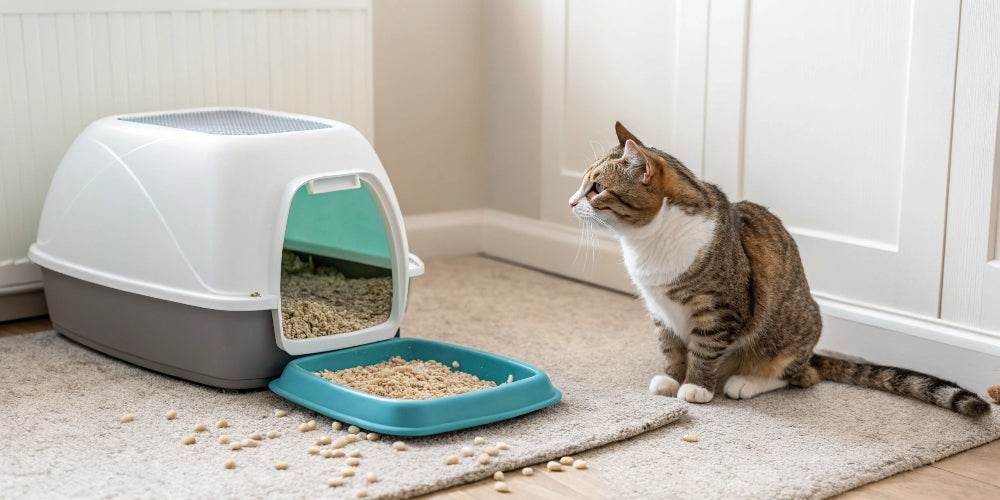
What is cat litter made of?
If we're going to bring a new feline companion into our home, a litter box is an essential accessory. In the wild, cats do their business by digging a hole in the ground and covering it up once they're done.
The litter box is essential for your cat to continue developing this behavior as naturally as possible. Litter is therefore a crucial element. When choosing, you'll find several types of litter that, at first glance, may seem unfamiliar. Clay litter or silica sand are the most common types of cat litter you'll find on the market.
Depending on the material they're made of, there are three: mineral, silica, and natural. Each has its advantages and disadvantages, and your choice will depend, among other things, on how much time you can dedicate to keeping the litter box clean. But don't forget that your cat will have the final say.
In this article, we'll tell you what cat litter is made of to guide you in your choice.
Mineral cat litter
Mineral sand is the most conventional and widely used type of sand you'll find on the market. It's also the most economical. It's a type of sand made from minerals, and we can find both clumping and absorbent types.
The latter is composed of sepiolite, a highly porous natural mineral, making it a highly absorbent litter. Its advantages include its affordable price and its ability to absorb liquids. However, its porous nature means that when cats dig, it produces a lot of dust, which can aggravate respiratory conditions in felines.
Within the mineral litter category, we also find the clumping type. This is made from a clay known as bentonite, which causes the sand to clump together when it comes into contact with liquids, leaving the rest of the sand completely clean. This makes cleaning the litter box easier. Plus, it won't need to be changed as often as the original.
Its introduction to the market is relatively recent, compared to absorbent mineral litter, which appeared towards the end of the 1940s. There are different types and textures of clumping litter, with a variety of scents and sizes to make it easy and comfortable for your cat to adapt.
Among the wide variety of clumping litter types, the Arquivet brand has a premium product: Classic Cat Litter 10 Kg, a 100% natural clumping litter with activated charcoal. This litter is a perfect combination of easy cleaning, respect for your cat's well-being, and odor control, thanks to the action of activated charcoal, a highly absorbent compound that is effective at neutralizing odors. In addition, we will have to add the almost absence of dust, preventing your cat from suffering from respiratory conditions.
Silica cat litter
Composed of tiny sodium silicate crystals, it is also known as crystal litter, given its color and shape. Its base is silica gel, a product that retains moisture very well. It is, therefore, a type of synthetic litter and one of the most absorbent for cats. This factor will allow the litter box to stay drier for longer.
Among its great virtues are its ability to neutralize unpleasant odors and its low dust production. Silica gel litter is becoming one of the most popular types of cat litter The most common sands on the market. In the link, you'll find the wide variety offered by the Arquivet brand, characterized by quality sands made with the most effective silica pearls. You'll also find a wide range of the mineral sands mentioned above.
Natural cat litter
This type of litter is the most environmentally friendly, as it's made from biodegradable materials such as wood, corn, and other plant fibers. These plant fibers absorb liquids, retaining moisture. When disposing of the litter, we can easily flush it down the toilet or place it in the organic waste bin.
With advances in the market, clumping litter made from organic compounds has also been developed, combining the absorption power of clumping litter with environmental friendliness. In this case, artificially enhanced wood fibers absorb urine quickly and safely. This neutralizes odors and permeates the environment with the woody scent of the fibers.
On the other hand, compared to the dust generated by clumping mineral litter, organic litter eliminates this problem, as it is designed for cats with asthma or respiratory sensitivity.
Finally, as you can see, there are various types of cat litter on the market that offer advantages and disadvantages. When choosing, we must consider, among other things, our lifestyle. Can we afford to change our cat's litter frequently? Do we not have much time in our daily routine to do this? The amount of time we can dedicate to cleaning the litter box will determine which type of litter we choose.
As we mentioned at the beginning, whether you've opted for one or the other, it's your cat who makes the decision. Cats generally prefer fine-grained litters, such as silica, that don't stick to their paws. On the other hand, there are scented types that can help maintain a clean environment.
If you want to know which one will suit your cat best, you can try several. However, mix it gradually with the previous litter, so as not to make a sudden change that could cause your cat to reject it.


